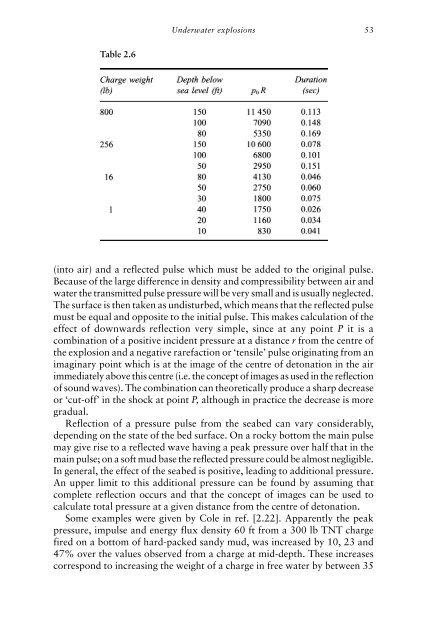A History of Research and a Review of Recent Developments
A History of Research and a Review of Recent Developments
A History of Research and a Review of Recent Developments
You also want an ePaper? Increase the reach of your titles
YUMPU automatically turns print PDFs into web optimized ePapers that Google loves.
Table 2.6<br />
Underwater explosions 53<br />
(into air) <strong>and</strong> a reflected pulse which must be added to the original pulse.<br />
Because <strong>of</strong> the large difference in density <strong>and</strong> compressibility between air <strong>and</strong><br />
water the transmitted pulse pressure will be very small <strong>and</strong> is usually neglected.<br />
The surface is then taken as undisturbed, which means that the reflected pulse<br />
must be equal <strong>and</strong> opposite to the initial pulse. This makes calculation <strong>of</strong> the<br />
effect <strong>of</strong> downwards reflection very simple, since at any point P it is a<br />
combination <strong>of</strong> a positive incident pressure at a distance r from the centre <strong>of</strong><br />
the explosion <strong>and</strong> a negative rarefaction or ‘tensile’ pulse originating from an<br />
imaginary point which is at the image <strong>of</strong> the centre <strong>of</strong> detonation in the air<br />
immediately above this centre (i.e. the concept <strong>of</strong> images as used in the reflection<br />
<strong>of</strong> sound waves). The combination can theoretically produce a sharp decrease<br />
or ‘cut-<strong>of</strong>f’ in the shock at point P, although in practice the decrease is more<br />
gradual.<br />
Reflection <strong>of</strong> a pressure pulse from the seabed can vary considerably,<br />
depending on the state <strong>of</strong> the bed surface. On a rocky bottom the main pulse<br />
may give rise to a reflected wave having a peak pressure over half that in the<br />
main pulse; on a s<strong>of</strong>t mud base the reflected pressure could be almost negligible.<br />
In general, the effect <strong>of</strong> the seabed is positive, leading to additional pressure.<br />
An upper limit to this additional pressure can be found by assuming that<br />
complete reflection occurs <strong>and</strong> that the concept <strong>of</strong> images can be used to<br />
calculate total pressure at a given distance from the centre <strong>of</strong> detonation.<br />
Some examples were given by Cole in ref. [2.22]. Apparently the peak<br />
pressure, impulse <strong>and</strong> energy flux density 60 ft from a 300 lb TNT charge<br />
fired on a bottom <strong>of</strong> hard-packed s<strong>and</strong>y mud, was increased by 10, 23 <strong>and</strong><br />
47% over the values observed from a charge at mid-depth. These increases<br />
correspond to increasing the weight <strong>of</strong> a charge in free water by between 35


